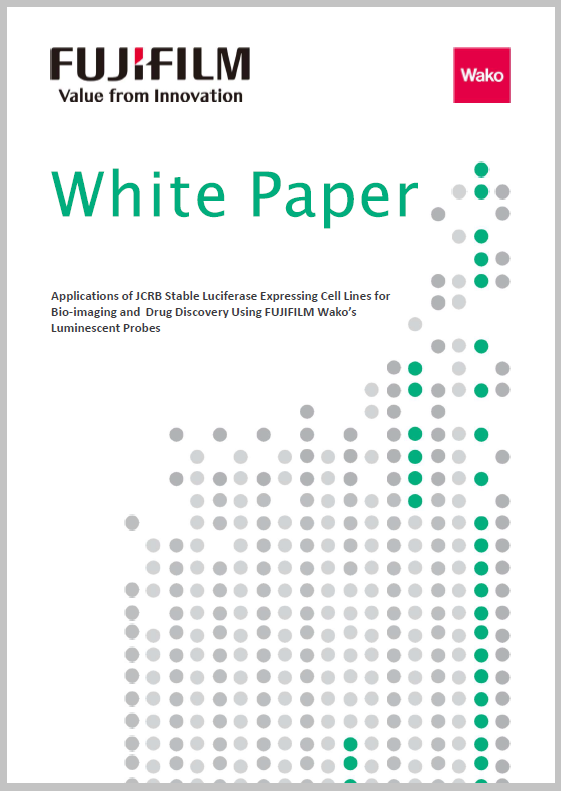Applications of JCRB Stable Luciferase Expressing Cell Lines for Bio-imaging and Drug Discovery Using Fujifilm Wako's Luminescent Probes
Overview
A luminescent probe is a substance that emits light in a chemical reaction due to change in the energy state of substrate from excited to ground state. This process is triggered by specific chemical reactions, making luminescent probes highly selective with low background noise, thereby enhancing signal detection. Since a luminescent probe covers a wide dynamic range , it is often used to investigate the dynamics of ATP and calcium ions. It is also used as a reporter gene to visualize specific cells or investigate gene expression. Fujifilm Wako provides various kinds of stable luciferase expressing JCRB cell lines.
JCRB Cell Lines
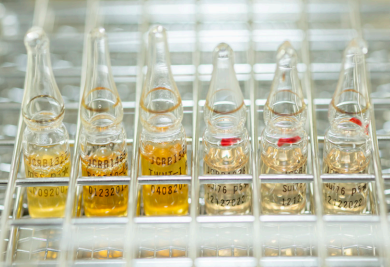
JCRB (Japanese Collection of Research Bioresources) is one of the most comprehensive cell banks in the world for pure and applied science, spanning many fields of research across the globe.
We have teamed up with the National Institute of Biomedical Innovation to bring you access to over 1,600 cell lines, including lung and glioma cell lines. In Europe, we are the exclusive distributor of JCRB's comprehensive catalog of cell lines.
Luciferase stably expressing cell lines
| JCRB No. | Cell-line name | Profile |
|---|---|---|
| JCRB1379 | MKN45-Luc | MKN45; Human Gastric Cancer |
| JCRB1383 | HT-29-Luc | HT-29; Human Colon Cancer |
| JCRB1387 | DU-145-Luc | DU-145; Human Prostate Cancer |
| JCRB1407 | NCI-H460-Luc | NCI-H460; Human Non-small cell lung cancer |
| JCRB1448 | BxPC-3-Luc#2 | BxPC-3; Human pancreatic adenocarcinoma cell line |
| JCRB1559 | MDA-MB-231-Luc | MDA-MB-231; Human Breast Cancer |
Applications of JCRB cell lines
1. Toxicology and Drug Screening
JCRB0134 (MCF-7) cell lines are used as valuable models for toxicology and drug discovery. They retain their genome over time and can be used to perform drug screening and facilitate patient specific drug development.
2. Benefit of Variety of Ethnic Background in Patient Targeted Cancer Therapies
JCRB offers a highly representative panel of cell lines in terms of ethnic and gender diversity, which could improve the success rate in identifying effective cancer therapeutics in cell culture models and thereby reduce drug failures in diverse human populations.
JCRB cell lines related luminescent probes
Fujifilm Wako provides AkaLumine-HCl and Coelenterazine that perform better than the substrates used in conventional luminescent probes in addition to D-Luciferin.
D-Luciferin (Potassium salt)
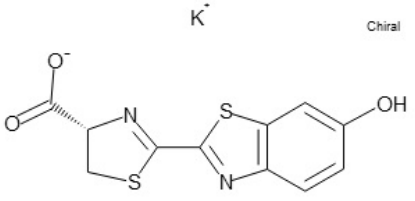
Struture of D-Luciferin (Potassium salt)
D-luciferin is a luminescent substrate derived from fireflies. Luciferin is converted to the luciferin-AMP intermediate by luciferase in the presence of ATP and magnesium, which is further oxidated to the excited state oxyluciferin. When oxyluciferin changes from the exited state to the stable situation, it releases energy as green-yellow luminescence (λmax= 565 nm), producing CO2 and AMP.1 This product is potassium salt and is freely soluble.
AkaLumine-HCl (TokeOni)
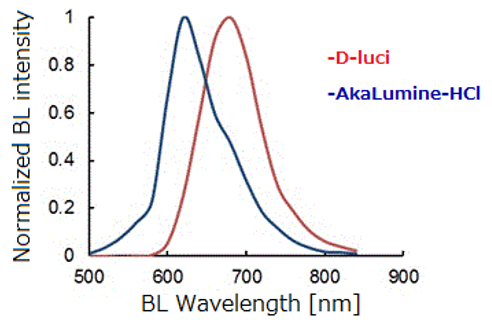
Figure 1 represents luminescence spectra of D-Luciferin and AkaLumine-HCl.
AkaLumine-HCl is a luminescent substrate of luciferase used for in vivo bioluminescence imaging. This substrate emits light in the near-infrared spectrum, specifically within the range of 670-680 nm. This wavelength is notably advantageous because it is less absorbed by water and hemoglobin, compared to traditional luciferin. Consequently, this characteristic of AkaLumine-HCl allows for more effective penetration and visualization of deeper biological structures within the body, enhancing the utility of bioluminescence imaging in medical research and diagnostics.2 Mice with LLC/Firefly luciferase (luc) subcutaneous tumor were administered intraperitoneally D-luciferin and AkaLumine-HCl at two substrate concentrations. After 15 minutes, the luminescent images obtained were analyzed quantitatively. As a result, it is found that when AkaLumine-HCl is used as a substrate, the substrate concentration does not easily affect the emission intensity.3
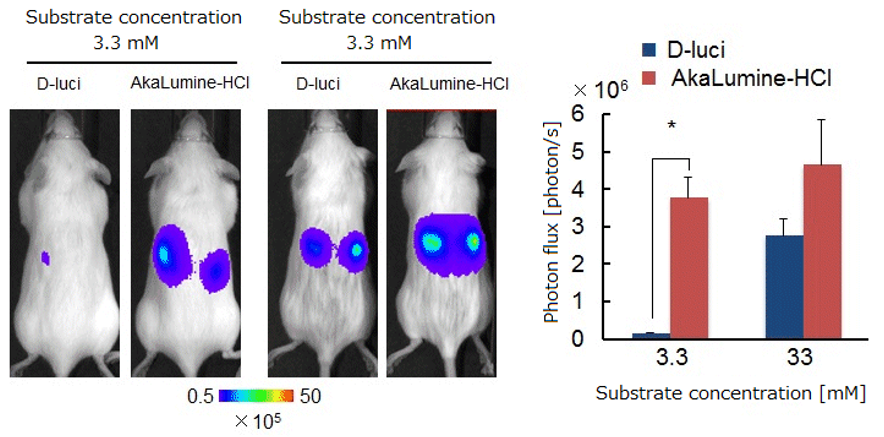
Figure 2 represents in vivo imaging data using mouse.
Coelenterazine h

Coelenterazine is a luminescent substrate for apoaequorin and Renilla luciferase, and coelenterazine h is a synthetic derivative of coelenterazine. The luminous intensity of the complex with aequorin is reported to be about 10 times stronger compared to coelenterazine native.
This product is a luminescent substrate for luciferases and aequorins derived from sea pansy and copepoda, and has also low toxicity and cell membrane permeability.
Figure 3 represents the visualization of chemiluminescence imaging of a mouse with Nanolantern-expressing tumors. This allows real-time imaging of intracellular structures in living cells.4
Luminescent probes products list
| Product Code | Product Name | Size |
|---|---|---|
| 126-05116 | D-Luciferin (Potassium salt) | 1 g |
| 126-05111 | 10 mg | |
| 120-05114 | 100 mg | |
| 012-26701 | Aka Lumine n-Hydrochloride | 1 mg |
| 018-26703 | 10 mg | |
| 016-26704 | 50 mg | |
| 012-26706 | 1 g | |
| 035-22991 | Coelenterazine h | 1 mg |
| 031-22993 | 10 mg | |
| 035-22996 | 100 mg |
Citations
- Griffiths MW.: J Dairy Sci. 1993 Oct, 76(10), 3118-3125.
- Iwano S., et al.: Tetrahedron, 2013 May, 69(19), 3847-3856.
- Kuchimaru T., et al.: Nat Commun. 2016 Jun;7:11856.
- Saito K., et al.: Nat Commun. 2012 Dec;3:1262.




